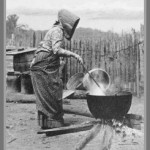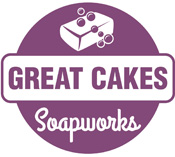The Making of Old Fashioned Soap
As promised, I wanted to share with you the differences between how soap used to be made and how it is made today. I’m going to start with the processes that were used to make old fashioned soap.
First, you need to know the basics. Here is a simple equation:
Lye + Fats (or Oils) = 75% soap, 25% glycerin
Saponification is the word used to describe the chemical reaction that takes place between the lye and fats to form soap and glycerin. Properly crafted handmade soap contains no lye, but cannot be made without it.

First, the lye: Potash lye was made by collecting the wood ash from their fires and placing it in a hopper. Water would then be poured over the ashes to leach the lye out. Once enough lye solution was collected, it was boiled until the strength of the lye was correct.
The hardest part was determining if the lye was the correct strength. This was done by floating either a potato or an egg in the lye solution. Most of the colonists felt that lye of the correct strength would float a potato or an egg with an area the size of a ninepence (about the size of a modern quarter) above the surface. To make a weak lye stronger, the solution could either be boiled down more or the lye solution could be poured through a new batch of ashes. To make a solution weaker, water was added.
Most early Americans either used animal fats from their farms or waste cooking grease to make soap. The fats had to be rendered, or cleaned, before they could be used for soap. To render, fats and waste cooking grease were placed in a large kettle and an equal amount of water was added. Then the kettle was placed over the open fire outdoors because it was such a smelly process. The mixture of fats and water were boiled until all the fats had melted. Then they added more water to the kettle, and the solution was allowed to cool down and left overnight. By the next day, the fats had solidified and floated to the top forming a layer of clean fat. All the impurities remained in the water underneath, and the fat was skimmed off the top.
Once the lye and fats were prepared, the soap making process could begin. The fats were placed in another large kettle with the lye solution and boiled over the open fire until soap was formed. This was determined when the mixture boiled up into a thick frothy mass, and a small amount placed on the tongue caused no noticeable “bite”. This boiling process could take up to six to eight hours depending on the amount of the mixture and the strength of the lye.
The difficulties the colonists endured in making soap arose from the lack of knowledge of the chemical processes involved and the inability to obtain lyes of known and dependable strengths. There were many superstitions which the colonists believe caused success or failure. For making good soap, the tide and the phases of the moon among other things were taken in account. A Pennsylvania Dutch recipe carefully warned that a sassafrasas stick was the only kind of implement suitable for stirring the soap and the stirring must be done always in the same direction.
Here are couple of old fashioned soap recipes:
A typical Southern recipe: “One half-box of concentrated lye, four pounds of grease, one pound of rosin, five gallons of water. Boil all together until the soap is made…then add a half pint of salt dissolved in a quart of water, boil a few minutes longer, and pour off.”
Field and Fireside gave the following soap recipe March 8, 1862: “Take one gallon of strong lye, add a half pound of shucks, cut up fine. Let the shucks boil in the lye until they are reduced to shreds. Then fish the shreds out, and put half a pound of crackling grease in, or six ounces of lard, and boil until it is sufficiently thick to make a good soap”.
As you can tell, these recipes aren’t very specific. Much of the early soapmaking was trial and error, and sometimes it could be highly frustrating. The diary of Elizabeth Ranch Norton, a niece of President John Adams, wrote in 1799 about having to make three batches of soap before she was able to make one barrel of soap fit for her family’s needs. The funny thing is, even with the knowledge we have today, you can talk to modern soapmakers and hear similar stories of failed batches of soap. Myself included!
I hope you enjoyed your history lesson! Tomorrow, I will share with you about the modern methods for making soap. It will be much shorter!
Sources:
Colonial Soap Making
A Little History of Soap
Page with Comments
Comments are closed.

can I use a copper pot?
@Janie – Yes, I believe you can.
I so enjoyed reading your ‘soap recipes.’ My mother used to make lye soap in a big pot over a fire in our backyard…mosttimes it took all day and it took a lot of sitrring. This was the only soap that we had and Mom used it to to bathe all of us (8 kids) in a big galvanized wash tub. She also used this soap to wash our clothes, scrubbing the clothes on a washboard. She hung our scrubbed clothes on several clothes lines in the yard … they looked so nice while drying in the wind.